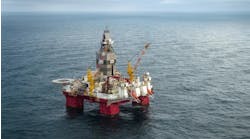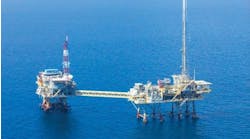William FurlowThe only federal lease in the Eastern US Gulf of Mexico has run into yet another road block on its journey to development. At stake is a potentially giant dry gas field Chevron USA is interested in developing. On the other hand, Florida considers any offshore development to be too much.
Technology Editor
The State of Florida has denied the consistency of the Destin Dome 56 development plan with its own coastal management program under the National Oceanic and Atmospheric Administration's Coastal Zone Management Act which says that all federal activities of this type must be reviewed by the affected states. In this case that includes Florida, Alabama, and Mississippi. Chevron USA has filed an appeal letter with the US Department of Commerce, but until the matter is resolved no drilling activity can be pursued.
Chevron's Destin Dome property lies about 25 miles off the northwest coast of Florida. The company holds 11 blocks under a 5-year lease, which remains under suspension of operations by the US Department of the Interior's Minerals Management Service while the development plan is reviewed.
Destin Dome 56 is located in water depths of 100-200 ft, making exploration relatively inexpensive. There is a vast infrastructure already in place that could transport the gas to shore.
Destin Dome 56 covers 11 contiguous lease blocks. Gary Jacobs, Senior Geologist with Chevron, said in an earlier interview that the proven reserves of the field are 674 Bcf of dry gas. This is a conservative estimate, and Jacobs said the potential reserves could be three times this large.
Chevron drilled three exploration wells in the area between 1987 and 1995. Each of these showed significant amounts of dry gas. Chevron filed the development plan on behalf of itself and partners Murphy E&P and Conoco.
Under the filed plan, Chevron will drill 12-21 wells to establish production, estimated at 300-450 MMcf/d. The gas would be transported via a 30-in. pipeline to a facility on Mobile Block 917, then to a processing facility in Mobile County, Alabama. Sandi Fury, project manager with Chevron, said the 12-21 well scenario is a worst-best case estimate. The probability that Chevron would drill 21 wells is remote. She said it is likely the company will drill no more than eight wells, but by over estimating, Chevron can assure that whatever the final results, they will be covered under the survey.
Simultaneously, the Minerals Management Service (MMS) has completed the first round of public scoping meetings in the three states affected by the project. The hearings gave the public a chance to discuss the Environmental Impact Study and produced the Scoping Report.
This report will be a part of the initial Environmental Impact Study (EIS), which the MMS is developing with the cooperation of the US Environmental Protection Agency, and US Army Corps of Engineers. Gary Goeke, with the office of the Regional Director of the MMS in Pensacola, Florida, said this study is progressing separately from the Florida letter. He said a draft version of the study will be complete by year's end. This version will then be open to public hearings during the development of the final EIS.
"We're moving forward with writing the EIS," he said. The final version of the study should be ready in late 1999, at which time the Secretary of Commerce will make a decision on the proposal. Before a decision can be made, Chevron must settle its differences with Florida, Fury said.
Chevron attempted to resolve Florida's questions in its appeal which was filed with the US Department of Commerce (DOC). Florida will review this appeal and write yet another letter that will be filed with the DOC.
Although Florida has denied consistently, Alabama is still reviewing the development plan, so it is not certain that Florida will be the only state to oppose the plan. Florida is scheduled to respond to Chevron's appeal by June 20. In the meantime, the three wells that have been drilled in the Destin Dome field will remain uncompleted.
"We can't do any activity until we get permitting," Fury said. Chevron hopes to complete one of the three wells drilled for production.
Florida's views
Carliane Johnson, with the Florida Governor's Office of Planning and Budgeting, said the state has not had adequate time to review the additional information it has requested from Chevron on the Destin Dome project. Johnson said the state has some specific problems that must be resolved for the plan to meet with state requirements.In a letter to the DOC, Chevron and other parties involved in the development plan said the state lists a number of items of concern, including the following:
- Chevron told the state that the monitoring plans for the project should be developed based on the results of the EIS. The state claims the monitoring system should be included in the development plan.
- Chevron also told the state that a decision to bury pipelines in water depths over 200 ft to alleviate potential conflicts with other user groups will be made during the development of the EIS. Florida says this evaluation is essential to determine anchoring conflicts near the pipelines and to determine if there is spatial conflict with the location of platforms. Florida is also interested in knowing the proposed route of pipelines and platform locations so they can determine if there will be a visual impact for residents and visitors.
- The state said it is concerned that the development plan will interfere with commercial fishing in state waters 15 miles from the development.
- The state is concerned about disturbance of live bottom areas on the seafloor near the development area. The letter states Chevron did not give enough detailed geophysical survey information to determine the amount of hard substrates the pipelay associated with this project would cause.
- The state is concerned about the discharge of drilling fluids, production effluents, and accidental release of oil or other toxic materials. Though Chevron does not expect to encounter any oil in this field it will store diesel oil on the facility to run equipment.
Chevron's views
Chevron has filed an appeal to the state letter basically answering all the points made by Florida. Whether or not this is enough information can only be decided by the US Department of Commerce which will evaluate the Florida letter and Chevron's appeal, and presumably the answer Florida has until June 20 to file. While none of these documents constitutes more than a part of the evaluation process, they do play a role in whether or not the EIS will be accepted.Johnson said that when the DOC makes a decision, it will not decide whether or not the development plan is consistent with the state plan, but will take the state opinion into consideration.
After the June 20 deadline, Johnson said the Secretary of Commerce will seek public input on the appeal receiving comments from both the public and the government agencies involved. From this input, the documentation and the results of the EIS the Secretary will decide to accept or reject the development plan.
What it means
Destin Dome is the first lease seeking development in the Eastern Gulf of Mexico. Because it is the first, it will require this extensive EIS process which not only takes time but is very expensive. However, if Chevron is successful, then other leases would have a much easier time qualifying for development. In addition, the approval of this development plan would mean Chevron could properly evaluate the formation that lies under these blocks and determine how much dry gas is really present.On the flip side, this would mean a defeat for the State of Florida, which has thus far kept development activities not only out of its state waters but also out of the federal waters of the Eastern Gulf of Mexico. A victory for Chevron might spell a change in the tide for this virgin territory of the US Gulf of Mexico.
Copyright 1998 Oil & Gas Journal. All Rights Reserved.


